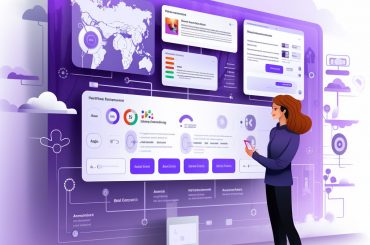Table of Contents
Businesses all around the world have been making advancements in every field. The only constant in life change. Changes are a necessary part of business these days. It is pretty well established that finance leaders of well-established businesses are constantly trying to use their data more effectively and increase their productivity. They have been trying to identify the areas where improvement is required. A very important aspect of the performance optimization of a business is the accounts payable process and the team that is supposed to manage it.
Regularly tracking the KPIs in finance departments help companies remove all the errors and optimize their performance.
This article is a guide to accounts payable KPIs and explains how key metrics can measure and improve the financial performance of a business.
What Are Key Performance Indicators (KPIs)?
A key performance indicator or KPI is a quantifiable measuring metric that is associated with measuring the performance of a company. Tracking KPIs in a business helps them keep a track of the business objectives and helps them achieve them. This way, businesses can make the right decision to achieve those goals.
Key Performance Indicators (KPIs) are essential factors that are used by many businesses to optimize growth. These factors help them analyze their manufacturing processes which are then utilized to measure the success relative to a set of already decided goals or objectives of the organization.
KPIs are important because they help you understand where you as an organization stand. It helps you set goals and gives you a deep insight into if you are making progress or not, if you are achieving your goals or not, and if you’re headed in the direction you want.
What Are Accounts Payable KPIs?
Key performance indicators (KPIs) in accounts payable are metrics that help a business and its accounts payable department get an insight into how their team can monitor the performance and achieve their business goals. These KPIs in accounts payable can help businesses optimize the existing AP workflows to allow the companies for a better success rate.
Why Does Your AP Department Need KPIs?
Businesses can never function without the accounts payable department. Accounts Payable KPIs help this department and the employees get a better understanding of the process to find answers.
AP KPIs give a hint to the organization and the employees that something might be wrong. It also tells them if the organization is working towards achieving its goals or not.
Moreover, with the help of these KPIs, you can develop a powerful and impactful strategy to optimize your performance. If you see that your company is not achieving its goals, you can alter the strategy and recognize all those areas where you need further improvement.
Examples of Accounts Payable KPIs:
Accounts Payable KPIs have been helping businesses of all scales to achieve their business goals. These KPIs allow them to hit business targets and benchmarks against other businesses or competitors in the industry.
Now we mention some of the most important and commonly used Accounts Payable Key Performance Indicators (KPIs):
Days payable outstanding (DPO)
- It is the average number of days that a company or business takes to pay the amount back that needs to be paid. A lesser value of DPO shows that the business is not taking advantage of the credit terms and is not as efficient as it is supposed to be.
Cost to process each invoice
- This productivity metric includes all the expenses to AP of the payments being processed – all the charges involved with the team members, operating expenses, and supplier charges.
Top payment methods
- If you force your suppliers to switch to electronic payment methods, this can prove to be very beneficial for your organization. But many businesses in this modern and advanced age, depend on checks. Checks are considered to be the most popular method used to pay suppliers. This KPI can therefore help AP departments identify the most favorable payment method to optimize their payment procedure.
Payment errors
- Any errors in the payment procedure that are faced by the clients can damage your reputation. It can affect your relationship with the customers and affect the credit terms. Therefore, you can measure and determine the payment errors your organization has been making to improve those issues and allow for better performance, increasing your sales revenue.
Average time to approve an invoice
- AP professionals usually face a challenge in their business, getting invoice and payment approvals. Therefore, this KPI can measure the average time an AP professional requires to approve an invoice.
Why Measure Your Accounts Payable KPIs
Accounts payable KPIs as mentioned earlier are essential to monitor and control the way you pay your vendors, sellers, dealers, suppliers, etc. As a business owner, you want to be sure that you’re receiving payments on time and in full and that is where account payable KPIs come to use. You can make sure that you’re reading all your payments in time with the help of accounts payable KPIs.
The amount of money spent on accounts payable is one of the largest expenses for most businesses therefore, this process needs to be optimized to achieve the goals. This is because it’s the process of paying suppliers, contractors, etc., and getting paid back by cash flow which can be considered the backbone of a business.
Accounts payable KPIs can help you:
- Estimate how well your business procedures are operating based on your supplier expenses.
- Determine any difficulties with payment procedures (such as late payments).
- Figure out how much cash your company has available for doing business at any given time in any given circumstance.
How Can AP Automation Improve Your KPIs?
Accounts payable (AP) is one of the most important functions in any company. It’s also one of the most overlooked aspects of the business. Without good management of AP, you may be at risk of missing out on important opportunities to improve your KPIs and increase profits.
The consequences of not having an AP system can be dire — it can lead to late payments, missed delivery dates, and even lost sales. All of these factors can harm your business’s financial health.
The good news is that there are many ways you can improve your KPIs by automating your accounts payable process.
Accounts payable is a key process in any business. It is not only the money that goes out to suppliers and clients but also the money that goes into your bank account. Any business that is not paying its bills on time, will have a hard time getting new customers and retaining existing ones.
Accounts payable KPIs are extremely important for all businesses. If you don’t know how to improve your AP KPIs, then you should start by looking at them from an executive perspective. Here are some tips on how you can improve your AP KPIs:
Make sure that you are tracking all of your accounts payable transactions accurately. You should be able to see what has been paid and when it was paid. In addition, you should have a record of any disputes or disagreements about payments made by clients. This way, you can avoid unnecessary disputes with your suppliers or clients in the future and save yourself money in the long run.
By keeping track of all transactions in one place, it will be easier for you to follow up on outstanding payments as well as send reminders when payments fall behind schedule or need to be made differently than expected
Automating the Accounts payable process by AP KPIs can:
- Automate the entry of the data to cut down the costs
- Lessen DPO by speeding approvals
- Don’t allow all the employees to process invoices
- Make the payment method automatic to work accordingly and to align with supplier discount terms. This can help you build strong relationships with customers and suppliers.
- Try to Increase accuracy as much as possible to cut down the expenses
- Segregate the duties to lessen the risk of frauds
- Move suppliers toward electronic payment methods
How Can Microsoft Dynamics 365 Help with Account Payable KPIs?
With the advent of Microsoft Dynamics 365, companies can track their accounts payable KPIs. The software provides a complete solution with financials, supply chains, and business intelligence.
Accounts payable (AP) is the part of the accounting system that records the transactions related to the payment of bills and other expenses. This system is used by businesses to keep track of their current liabilities and receivables. The main KPIs that should be tracked include:
- Number of days to pay invoices
- Days delinquent
- Days overdue
- Percentage of sales billed on a time
Accounts payable KPIs are important to the success of your company. These KPIs can help you determine what needs to be done to improve accounts payable processes and allow you to forecast when the cash is going to run out.
The most common KPIs for accounts payable include:
- Directly billed invoices received
- Courier pick-up
- Cash flow
FAQs
What are key performance Indicators?
KPIs are estimates used to assess the performance of a business. KPIs can be quantitative or qualitative and are targets that can help you estimate your overall progress against the most strategic objectives you follow in your department.
Why are key performance indicators so important?
KPIs are important because they help you understand where you as an organization stand. It helps you set goals and gives you a deep insight into if you are making progress or not, if you are achieving your goals or not, and if you’re headed in the direction you want.
What Does KPI Stand For?
KPI stands for Key Performance Indicator.
What Are Examples Of Accounts Payable KPIs?
A few examples of AP KPIs include:
- Days payable outstanding
- Top payment methods
- Invoices processed per employee
- E-invoices as a percentage of total invoices
- Average time to approve an invoice
- Cost to process each invoice
- Payment errors
- Percentage of supplier discounts captured





